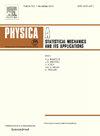利用量子粒子工质的不可逆功接近零的量子热机
IF 3.1
3区 物理与天体物理
Q2 PHYSICS, MULTIDISCIPLINARY
Physica A: Statistical Mechanics and its Applications
Pub Date : 2025-04-21
DOI:10.1016/j.physa.2025.130599
引用次数: 0
摘要
量子热力学领域的主要障碍围绕着在纳米尺度上运行的量子热机的开发和实际应用。与量子工作机体相关的主要挑战之一是 "量子摩擦",它是指量子级间转换造成的不可逆功浪费。因此,要构建可逆量子循环,就必须利用绝热捷径。然而,在现实量子物质中实现这种捷径的实验极其复杂,对于现实材料来说往往无法实现。在本研究中,我们提出了一种量子热引擎,它利用了等离子体天融晶格。通过严格的分析,我们证明量子天离子物质由于其拓扑保护而表现出近乎零的不可逆功。因此,我们的引擎无需绝热捷径即可运行。我们通过数值计算检验并观察到,当系统处于量子天融阶段时,传播态与初始态的区别仅在于几何和动力学阶段。绝热演化导致过渡矩阵元素接近于零,因此系统显示出接近于零的不可逆熵。通过使用等离子体调制器和电场,我们驱动了量子循环。构建量子工作体的基本构件是等离子体晶格中的单个 Skyrmions。因此,我们可以通过操纵量子天元的数量来精确控制发动机的输出功率和完成的热力学功。本文章由计算机程序翻译,如有差异,请以英文原文为准。
Quantum heat engine with near-zero irreversible work utilizing quantum skyrmion working substance
The primary obstacle in the field of quantum thermodynamics revolves around the development and practical implementation of quantum heat engines operating at the nanoscale. One of the key challenges associated with quantum working bodies is “quantum friction,” which refers to irreversible wasted work resulting from quantum inter-level transitions. Consequently, the construction of a reversible quantum cycle necessitates the utilization of adiabatic shortcuts. However, the experimental realization of such shortcuts for realistic quantum substances is exceedingly complex and often unattainable for realistic materials. In this study, we propose a quantum heat engine that capitalizes on the plasmonic skyrmion lattice. Through rigorous analysis, we demonstrate that the quantum skyrmion substance exhibits near-zero irreversible work owing to its topological protection. Consequently, our engine operates without the need for adiabatic shortcuts. We checked by numerical calculations and observed that when the system is in the quantum skyrmion phase, the propagated states differ from the initial states only by the geometrical and dynamical phases. The adiabatic evolution leads to near-zero transition matrix elements, consequently the system demonstrates near-zero irreversible entropy. By employing plasmonic mods and an electric field, we drive the quantum cycle. The fundamental building blocks for constructing the quantum working body are individual skyrmions within the plasmonic lattice. As a result, one can precisely control the output power of the engine and the thermodynamic work accomplished by manipulating the number of quantum skyrmions present.
求助全文
通过发布文献求助,成功后即可免费获取论文全文。
去求助
来源期刊
CiteScore
7.20
自引率
9.10%
发文量
852
审稿时长
6.6 months
期刊介绍:
Physica A: Statistical Mechanics and its Applications
Recognized by the European Physical Society
Physica A publishes research in the field of statistical mechanics and its applications.
Statistical mechanics sets out to explain the behaviour of macroscopic systems by studying the statistical properties of their microscopic constituents.
Applications of the techniques of statistical mechanics are widespread, and include: applications to physical systems such as solids, liquids and gases; applications to chemical and biological systems (colloids, interfaces, complex fluids, polymers and biopolymers, cell physics); and other interdisciplinary applications to for instance biological, economical and sociological systems.

 求助内容:
求助内容: 应助结果提醒方式:
应助结果提醒方式:


